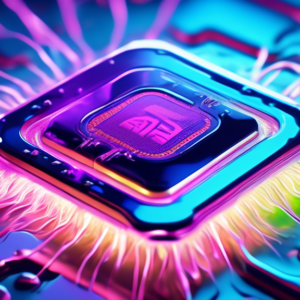AMD’s Ambitious Chip Plans: Power and Efficiency in Focus
Advanced Micro Devices (AMD), a prominent name in the semiconductor industry and a close partner of Nvidia, is charting a course towards building powerful, energy-intensive chips. While the company aims to push the boundaries of computational power, it’s steering clear of the extreme scale embodied by Cerebras’ trillion-transistor behemoth. This strategic decision reflects AMD’s commitment to balancing performance with practicality, targeting key markets like data centers and artificial intelligence (AI).
The Power of Density: AMD’s Approach to Chip Design
AMD’s focus lies in optimizing chip architecture for greater transistor density. This approach involves packing more transistors into a given area, enhancing processing power without resorting to massive chip sizes. The rationale behind this strategy is multifaceted. Smaller chips translate to lower manufacturing costs and reduced power consumption, crucial factors in the fiercely competitive semiconductor market.
Furthermore, denser chips facilitate faster data transfer within the chip itself, leading to improved overall performance. This is particularly crucial in data-intensive applications, such as AI and high-performance computing (HPC), where speed is paramount.
Energy Efficiency: A Balancing Act
While AMD is pursuing powerful chips, the company recognizes the growing importance of energy efficiency. The increasing demand for computational power, driven by trends like AI and cloud computing, comes with a corresponding rise in energy consumption. AMD’s strategy involves optimizing chip architecture to deliver maximum performance with minimal energy usage.
This focus on efficiency aligns with the broader industry trend towards sustainability. Data centers, major consumers of processing power, are under increasing pressure to reduce their environmental footprint. By offering chips that strike a balance between power and efficiency, AMD caters to this crucial market need.
Cerebras’ Trillion-Transistor Giant: A Different Path
Cerebras’ Wafer Scale Engine, with its trillion transistors, represents a radical departure from conventional chip design. While this approach offers immense computational power, it comes with significant challenges in terms of manufacturing complexity, cost, and power consumption. AMD’s decision to avoid this scale underscores a pragmatic approach, prioritizing practicality and market viability.
Cerebras’ technology targets specialized applications where extreme computational power is essential, such as scientific research and advanced AI development. AMD, on the other hand, aims to serve a broader market, focusing on chips that deliver high performance within more manageable parameters.
Intel: The Main Competitor
In the competitive landscape of the semiconductor industry, AMD’s primary rival remains Intel. Both companies are vying for dominance in key markets, including data centers and personal computing. AMD’s focus on powerful, energy-efficient chips positions it as a strong contender, challenging Intel’s long-standing dominance.
The rivalry between AMD and Intel drives innovation, benefiting consumers with increasingly powerful and efficient processing solutions. This ongoing competition fuels the advancement of chip technology, pushing the boundaries of what’s possible in computing.
Nvidia: A Close Partner
While AMD and Nvidia compete in certain segments, they also maintain a close partnership. Nvidia, a leader in graphics processing units (GPUs), collaborates with AMD on various fronts, including chip design and software development. This partnership leverages the strengths of both companies, fostering innovation and delivering advanced solutions to the market.
AMD’s CPUs and Nvidia’s GPUs often find themselves working in tandem, particularly in demanding applications like gaming and AI. This synergistic relationship highlights the importance of collaboration in the semiconductor industry, where shared expertise can lead to breakthroughs.
The Future of AMD’s Chip Strategy
AMD’s commitment to building powerful, energy-efficient chips is poised to shape the future of computing. As demand for computational power continues to surge, driven by trends like AI, cloud computing, and the Internet of Things (IoT), AMD’s focus on performance and efficiency will be crucial in meeting these evolving needs.
The company’s strategic decision to avoid the extreme scale of Cerebras’ trillion-transistor chip underscores a focus on practicality and market relevance. AMD’s chips are designed to deliver high performance within manageable parameters, addressing the needs of a broad range of applications.
In the ever-evolving landscape of the semiconductor industry, AMD’s focus on power, efficiency, and strategic partnerships positions the company as a key player. Its commitment to innovation and its rivalry with Intel will continue to drive advancements in chip technology, shaping the future of computing.
